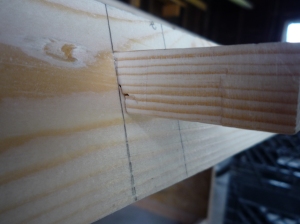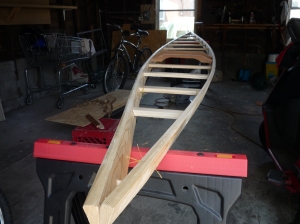(check out part one of the Greenland kayak build here)
It’s been a brutal summer here in St. Louis. With almost no rain, no humidity, and 100+ degree temperatures, the thought of getting into the water with a new kayak is more enticing than ever. So, I’ve been in the workshop quite a bit. The previous post showed the progress up to the completed deck of the kayak. Here’s a look at the completion of the frame and cockpit.
The first task was to add the ribs. While the literature made this step seem nerve-rackingly difficult, it actually came together without too much difficulty.
I took the time to put the deck on blocks, simulating the depth I’d have after adding ribs, and test the fit. Snug, but comfortable.
Rib bending was a crash course in working with hardwood (everything up till now had been pine or douglas fir). Everything came together in the end though.
After the ribs cooled, it turned out that a few were a bit out of alignment with the rest. I was so tempted to just ignore it, but I knew I’d regret it later. So the next day I made a few replacements to get everything flush.
Next came stem pieces to define the shape of the bow and stern, followed by the keelson and chines. The keelson and chines were joined with a running lashing. The lashings allow for slight flexibility in the joints, which then absorb the energy of waves, impacts, etc. This flexibility is one of the key components of traditional skin-on-frame kayak design, and makes for a very seaworthy craft.
With the hull complete, it started to really feel like there was an actual kayak in my garage.
The next challenge was the masik, the thigh-bracing deck beam that also serves as the rest for the cockpit coaming. Since the masik is under greater stress than the other deck beams, it needs to be exceptionally strong. A naturally curved hardwood branch is ideal. Unfortunately, after chiseling away at what appeared to be a prime specimen of naturally curved hickory, it turned out to be rotted completely through.
While hacking away at what turned out to be a rotten branch was discouraging, I tried a new tactic. I epoxied two pieces of red oak lumber together, rough cut the shape with a jigsaw, then worked it down to size with a spokeshave and some sandpaper. The finished product felt as sturdy as a baseball bat.

No post about woodworking is complete without at least one picture with a preposterous number of clamps.
After adding the deck ridges (which turned out to take much longer than expected), I decided to get creative by laminating a cockpit coaming. I had no idea how messy this would be. But, 7 layers of basswood and a full batch of epoxy later, I had a finished coaming, and finally…
A completed frame. This brings us to the home stretch- all that’s left is the skinning process, deck lines and accessories, and a Greenland-style paddle. Check back soon for part three!













![By Alexander Tidd [Public domain], via Wikimedia Commons](https://i0.wp.com/upload.wikimedia.org/wikipedia/commons/thumb/b/bd/Aerial%40sendai.jpg/640px-Aerial%40sendai.jpg)
![By Engbretson, Eric [Public domain], via Wikimedia Commons](https://i0.wp.com/upload.wikimedia.org/wikipedia/commons/thumb/d/de/Grass_Carp.jpg/300px-Grass_Carp.jpg)









![By User:Erik (private, Uffe Wilken) [GFDL (http://www.gnu.org/copyleft/fdl.html) or CC-BY-SA-3.0 (http://creativecommons.org/licenses/by-sa/3.0/)], via Wikimedia Commons](https://i0.wp.com/upload.wikimedia.org/wikipedia/commons/thumb/4/46/Franz_Josef_Fjord.3.jpg/640px-Franz_Josef_Fjord.3.jpg)
![By flickr user wili hybrid (flickr.com) [CC-BY-2.0 (http://creativecommons.org/licenses/by/2.0)], via Wikimedia Commons](https://i0.wp.com/upload.wikimedia.org/wikipedia/commons/thumb/d/d7/Greenland_kayak_seal_hunter_2006.jpg/320px-Greenland_kayak_seal_hunter_2006.jpg)
![By Anonymous illustrator, possibly Otto Sinding (Book scanned by Nasjonalbiblioteket) [Public domain], via Wikimedia Commons](https://i0.wp.com/upload.wikimedia.org/wikipedia/commons/6/64/Eskimo_Life_kaiak-frame.png)
